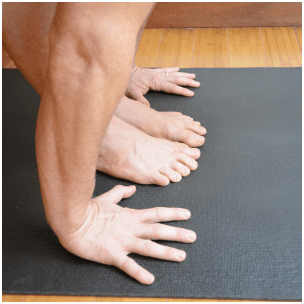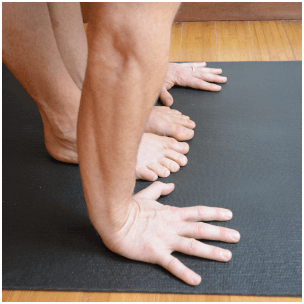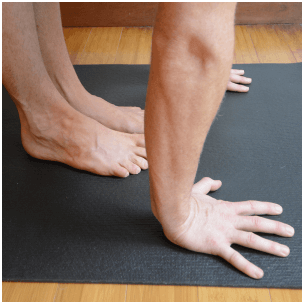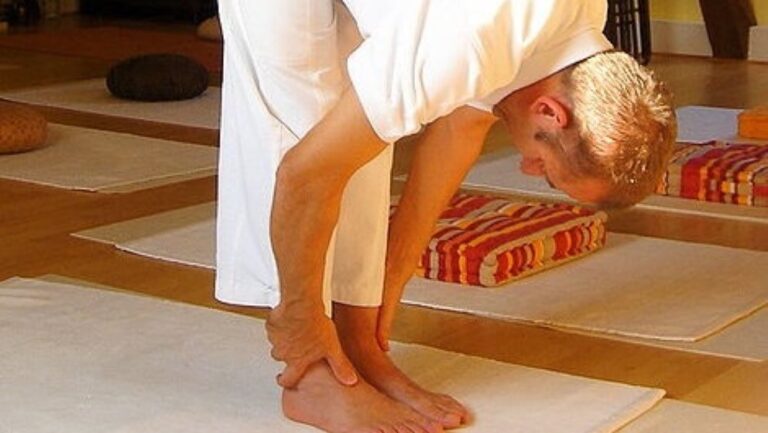In this fourth of 8 articles, we continue along the journey of sun salutations and explore the next movement – the “look up”
http://www.yoganatomy.com/sun-salutations-4-look-up-yoga-anatomy/ – David Keil
Don’t Just Look Up – Push Up!Let’s continue along the journey of sun salutations. We first explored samastitihi and then raised our arms over our heads. The last thing we did was explore the forward fold. In this article we are going to explore the next movement in sun salutations – the “look up”
I know what you’re saying… Look Up? Big deal. Well, it is a big deal, and I’ll tell you why. How you look up in this moment is setting you up for the next movement, the jump back. That movement is the seed of all handstands and other arm balances that come later. I’m getting ahead of myself. There are some important and fundamental patterns established by:
Placing your hands on the floor – where and why?
Leaning into your hands and establishing groundedness.
The pattern of muscular contraction that is created.
Where Should I Put My Hands?

FINGERS IN ALIGNMENT WITH TOES – TRADITIONAL
The most traditional approach to placing the hands on the floor is to line up the fingertips with the toes. There certainly isn’t anything inherently wrong with this. I would suggest that this is where you’re aiming if you are focused on a traditional approach. However, depending on how open your hamstrings are, this may or may not be possible in the beginning. Sometimes, even if it is possible, it loads the lower half of the body with so much tension, that it is a detriment to other patterns we want to create.
Personally, I put my fingers just in front of the line of my toes. I may put them a little further out than that on my first couple of sun salutations. By the time I get to the end of doing sun salutations I might have my fingers in line with my toes. I’m not convinced that this is the goal here anyway, it’s just an ideal. But even after 15 years of steady practice, my hamstrings just seem to hold on to a bit of tension.

MY PERSONAL PREFERENCE FOR HAND PLACEMENT
In my own yoga practice it’s more important that I feel the floor with my hands. I have found this to be an insightful connection to make with all of the arm balances within practice. So, if you really want to do handstands, keep reading. If the hands are in line with the toes and your hamstrings are still tight, you will either feel like you’re going to fall over when you lean your weight forward or your hands won’t go flat. Practitioners in this scenario have a tendency to lean back and miss out on the hand to floor relationship.
There is a simple solution for beginning to create this relationship. All you have to do is move your hands forward which will make them more likely to go flat. You will also have space to lean into those hands.
Why Would You Want To Lean Into Your Hands?
By leaning into your hands, you establish the hand to floor relationship that I just talked about. However there are two additional elements that are important here:
1. What the hamstrings do when you lean into your hands
2. What muscles in your arm respond to leaning forward
Get your hamstrings to relax
Let’s look at the same practitioner we described above. They have tight hamstrings and fingers in line with the toes. Their fingers are possibly not flat on the floor. Where do you think their weight is? It’s in their feet primarily, possibly even leaning back as we described in Sun Salutation Part 3.
That seems normal enough, doesn’t it? With the weight in the feet, it means that the hamstrings have to tighten enough to stabilize you. Most people find hamstrings an obstacle in forward bending. In that sense, when you do this movement, would you rather be tightening or releasing your hamstrings? If you were to lean into your hands, you would take the weight out of the hamstrings and, dare I say, relax them a bit.

EXPLORING HANDS FURTHER FORWARD MAY HELP YOU FIND HOW TO RELAX YOUR HAMSTRINGS.
Yes, what I’m saying is that if you lean into your hands and take your body weight into them while in a forward fold, your hamstrings will not have to work as hard to hold you up.
But that’s minor compared to the topic at hand, which is supposed to be the look up. I sure have been taking my time to get here.
Feeling the armpits
Personally, I find feeling the armpits to be the most important reason to lean into your hands. It’s a perfect example of a pattern that we learn in sun salutations that can carry through to so many other places in our practice. In this case, that pattern is arm balances. I dedicated an entire chapter in my book to the pattern of arm balances and this is where it all starts.
When you lean forward into your hands, you will resist your body weight from one of two places. You will resist your body weight from the core of your upper body and shoulder girdle or from the more superficial muscles of the arm and shoulder girdle. The vast majority of people default to the latter of those two.
The muscles that most people default to are the superficial muscles such as the triceps, deltoids, and maybe pecs in the front of the chest. I’m not saying that these shouldn’t contract at all. Let’s not be ridiculous. What I am saying is that those are not the main muscles you want to connect to here or in later arm balancing postures.
You want to get to the core of the upper body. My teacher, John Scott refers to this as the armpit bandha. In order to actively use your armpit you will have to respond from different muscles as you lean forward into your hands. The specific muscle you want the response from is your serratus anterior muscle, which is very important for stabilizing the shoulder girdle and lifting the chest away from the floor through all arm balances.
We can talk more about this when we do the next piece of the sun salutations, the jump back.
Go ahead and have a play for a moment. Just stand up, do a forward bend, and play with where you put your hands relative to your feet. Then put your hands forward of the line of your toes and lean into them. Notice where your body catches you from. Chances are you default from the triceps. If so, see if you can switch from the triceps, to the serratus. This will be felt on the rib cage just below the armpit.
Finally – The Look Up!
Let’s see if we can tie all of this together and I’ll share my personal choice (bias) for how to look up. There are two ways you can look up. One is by lifting onto the fingertips and flattening your back (very common). The second is to keep your hands flat and look up from them. I’m sure there are a few other variations out there but these are the most prominent.
Looking up with fingertips is probably the most common and, of course, there are a number of good reasons to do it. Personally, I think it’s good both for the beginner and the advanced practitioner.
It’s useful for the beginner because they often can’t reach the floor anyway. If they can reach the floor with their fingertips, that’s a good place to start. If they have tight hamstrings and their spine is rounding, reaching just to the fingertips along with bending knees will help keep their spine elongated. This scenario is a good and valid reason to look up with fingertips on the floor.
For the advanced person I’ll make a couple of assumptions. One is that their hamstrings are already open and long, and they don’t have to worry about tightening them. In fact, adding some tension might be a good thing. If they are advanced, they might have already established the good patterns for arm balances in other ways. If that’s the case, there is certainly nothing “wrong” with looking up from your fingertips.
But let’s talk about those between the beginner and the advanced practitioner. After all, that’s a large part of the yoga community. Is there still a little tension left in the hamstrings that you need to get rid of? Still working to find that ever elusive handstand? As I say in Functional Anatomy of Yoga: Wait, what’s that I hear you saying? You’ve been working on handstands for years? Still doing the same things with no results? Then, this is for you!
When you look up from your fingertips (and by the way, I dare you to do this right now!), two main areas of muscles are going to tighten to both bring you into that position and to help stabilize you in it. Those two areas are the paraspinal muscles (especially in the lower back), and the hamstrings (which are rotating your pelvis to lift your spine). Apparently those two things are connected.
So, if you are leaning forward, not taking your weight into your hands, and then looking up from your fingertips, you’re tightening your hamstrings the whole way through this section of sun salutations! Are you intending that? Do you want that to happen?
If, however, you have leaned forward into your hands and you initiate the look up from your hands and “armpit bandha”, your hamstrings were “off” when you leaned into your hands. They won’t have to tighten when you look up because it’s your hands that are lifting your body weight.
But more importantly, you are connecting the hands on the floor to the armpit, which you’re going to need in the next part of this series, which is, the jump back.
Conclusion
Now, it’s true that you won’t lift your body and torso up nearly as much as you would if you were going onto your fingertips. So? The question you need to be asking yourself is how are these movements, or patterns, that you are creating going to help you through more advanced postures later on? Are you taking advantage of an opportunity?
Best of all, you get to decide how you want to do it. If you’ve been struggling with handstands for a while, try moving your hands forward a bit, leaning in, and moving from your armpits. Do this until the next article in the series and let’s see if it changes.

